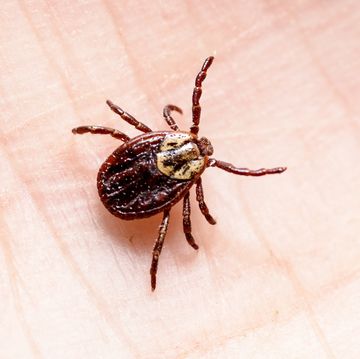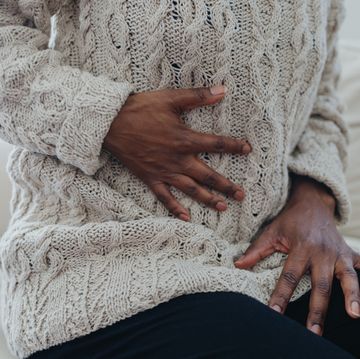- Due to unprecedented snow and ice, more than 4 million people in Texas are currently without power.
- Many people are trying to figure out alternative methods of heating in record-breaking freezing temperatures.
- Officials say people are using risky heat sources that have increased emergency calls for carbon monoxide poisoning. Here’s why the clear, odorless gas is so dangerous.
This week, Texas was blanketed in unprecedented snow and ice. More than 4 million residents of the state are currently without power, CNN reports, meaning many people are trying to figure out alternative methods of heating in record-breaking freezing temperatures.
At the time of publication, at least 20 people have died from the unthinkable cold. One family who was trying to keep warm died after flames spread from their fireplace. And in the Houston area, a woman and her child died from carbon monoxide poisoning after running a car in their garage to try and heat up their home. A man and another child in the home were taken to the hospital.
The entire region has been slammed with emergency carbon monoxide poisoning calls as people desperately look for heat sources. Harris County Fire Marshall Linda Christensen warned people about the dangers of the odorless gas in a press conference on Tuesday. “We have to get the message out. People are dying,” she said. “We are losing our family members to carbon monoxide poisoning.”
The Cy-Fair Fire Department, located in Harris County, Texas, also warned local residents about carbon monoxide poisoning.“We have responded to multiple carbon monoxide poisoning calls. Fourteen people, including at least seven children have been transported by @cyfairfd for CO poisoning in the last 24 hours,” they wrote on Twitter. “All were using grills to heat their homes. CO is an odorless/colorless gas that can kill you.”
Carbon monoxide poisoning isn’t something that’s often discussed, but it is incredibly dangerous. Here’s what you need to know to stay safe.
What is carbon monoxide poisoning, exactly?
Carbon monoxide is a clear, odorless gas that is found in fumes produced whenever you burn fuel in cars or trucks, small engines, stoves, lanterns, grills, fireplaces, gas ranges, or furnaces, according to the Centers for Disease Control and Prevention (CDC). Carbon monoxide can build up indoors and poison people and animals who breathe it in.
What are the symptoms of carbon monoxide poisoning?
Carbon monoxide symptoms are similar to those of the flu, the CDC says. They include:
- Headache
- Dizziness
- Weakness
- Upset stomach
- Vomiting
- Chest pain
- Confusion
If you breathe in too much carbon monoxide, it can cause you to pass out and even die, the CDC says, noting that people who are sleeping or drunk can die from carbon monoxide poisoning before they even develop symptoms.
The big problem with these symptoms is that they can easily be written off as being caused by something else, says Osita Onugha, M.D., a thoracic surgeon at the John Wayne Cancer Institute at Providence Saint John’s Health Center in Santa Monica, Calif. “These are not symptoms that most people would think are due to carbon monoxide poisoning,” he says.
Why can carbon monoxide poisoning be deadly?
Every year, more than 20,000 Americans visit the ER for carbon monoxide poisoning and 400 die from it, per the CDC. Carbon monoxide actually replaces oxygen in your red blood cells, explains Dr. Onugha. “As a result, you’re not able to take in oxygen,” he says.
When you can’t take in enough oxygen, your organs are affected and they “shut down,” says Jamie Alan, Pharm. D., Ph.D., an assistant professor of pharmacology and toxicology at Michigan State University. It’s “fairly unlikely” that most people will notice symptoms as they’re being poisoned, Alan says, allowing the poisoning to progress unchecked.
How is carbon monoxide poisoning treated?
It depends on the severity of the situation. If it’s caught early enough, a person will be given supplemental oxygen, Alan says. In more critical cases, oxygen therapy with a hyperbaric chamber will be used, if it’s available. “We want to use high flow oxygen,” to try and “ overload the carbon monoxide molecules,” Dr. Onugha says.
❗If you suspect that you or a loved one has carbon monoxide poisoning, call 911 immediately and try to get outdoors to breathe in fresh air.
How to prevent carbon monoxide poisoning
The CDC has very specific instructions on what to do to lower the risk of carbon monoxide poisoning, including:
- Install a battery-operated or battery back-up carbon monoxide detector in your home. This will alert you when levels get too high.
- Have your heating system, water heater, and any other gas, oil, or coal burning appliances serviced by a qualified technician every year.
- Do not use portable flameless chemical heaters indoors.
- Have your refrigerator serviced if you smell an odor leaking from it (as this could mean it’s leaking carbon monoxide).
- When you buy gas equipment, buy only equipment carrying the seal of a national testing agency, such as Underwriters’ Laboratories.
- Make sure your gas appliances are vented properly.
- Have your chimney checked or cleaned every year.
- Never patch a vent pipe with tape, gum, or something else.
- Never use a gas range or oven for heating.
- Never burn charcoal indoors.
- Never use a portable gas camp stove indoors.
- Never use a generator inside your home.
- Have a mechanic check your vehicle exhaust every year.
- Never run your vehicle inside a garage that is attached to a house, even with the garage door open.
- Always open the door to a detached garage when you run a vehicle inside.
Go here to join Prevention Premium (our best value, all-access plan), subscribe to the magazine, or get digital-only access.
FOLLOW PREVENTION ON INSTAGRAM












